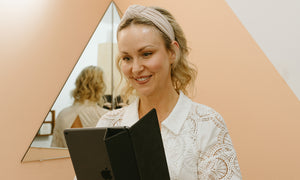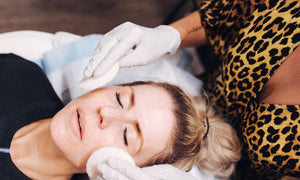Taking The Fear Out of Fillers
Creating a natural, youthful, balanced result with facial balancing fillers.
If the term “Filler” scares you, you’re not alone. We’ve all seen images of celebrities (or ran into an old acquaintance) and immediately sense they no longer appear like themselves. You can’t put your finger on it, but you take one glance at them and there’s something unnatural looking about their appearance. That’s why the #1 concern/fear when it comes to fillers is looking “overdone” or “unnatural”.
Take a look below at one of our clients where we achieved Facial Balancing:
Facial Balancing Before and After
The Good News
For every “overdone” filler look you may come across, there is a strikingly beautiful person you wouldn’t even notice had filler…that’s when you know facial balancing has been achieved.
I recently heard this concept of 'anti-aging filler' versus 'augmentation filler'. Anti-aging filler is defined as strategically placed amounts and locations of filler to restore the supporting structures of the face that have been lost over time, creating beautiful facial balancing results.
Whereas, filler used to “augment” is more about adding volume to the face in areas where we never really had it to begin with. It's this type of filler placement that makes people often look unlike themselves, and why some clients are fearful the second they hear the word 'filler’.
The difference between Augmentation and Facial Balancing may sound like semantics, but the outcomes are anything but. Take a look at a filler client who was treated with too much of only one type of filler placed all over, for example, and I bet the first words that will come to mind are “overdone and unnatural.” What we aim for when using fillers is a distinct, balanced, almost unnoticeable result. It’s YOU….but better. So, how do we get there? We must first understand the underlying causes of facial aging.
Facial Balancing Before and After
Facial Aging
Let’s talk a little bit about how the face ages over time. While most people think the cause of facial aging points only to the loss of elasticity and collagen in the skin, there are in fact three key reasons for facial aging: volume/fat loss (about a teaspoon per year), bone loss, and changes in the quality of the skin.
When it comes to filler, we must address the changes in the deep and superficial fat pads, as well as actual bone structure that supports your face (the critical support that keeps us looking youthful, supported, fresh, and our faces ‘high and tight’). According to medical literature, the failure to address the multifaceted changes in both the skeletal foundation and shape of the face could limit the potential benefit of any rejuvenation treatment.
So, when we talk about the optimal use of fillers, it's not actually about “filling” at all. It's more about creating facial support that helps to restore a youthful shape and proportions - a.k.a. ‘The Triangle of Youth’. Simply, this is the term in the aesthetic world to describe the youthful inverted triangle of the face. Think about high cheekbones, fuller cheeks and a well-defined jawline. There are no peaks and valleys. The transitions between one part of the face and another are smooth and seamless.
As we age, the triangle turns, with the broad base mimicking a square along a sagging jawline. The face becomes more oblong, cheeks flatten and jowls appear due to the loss of support from areas higher up in the face. Of course there is decreased collagen production and the influence of gravity as well.
The good news is that there are many (minimally invasive and relatively affordable) sophisticated tools and techniques that we are able to utilize to help prevent and treat the ‘pyramid of age’.
Here's how we start when assessing your personalized facial balancing treatment:

1. We first assess the temples (that area between the end of your brow and the hairline): Is it depleted, with a scooped out shape? Is the tail of the brow unable to be seen when you look in the mirror? Are the brows drooping?
If the answer is “yes”, we look to support this temporal area to not only restore a more youthful and healthy shape to the face, but also to support the brow, the under eye, even the cheek and jawline. A healthy appearance of the temples often equates to an overall healthy appearance.

2. Next, we look at the mid-face and under-eyes: Do the eyes look drawn, tired, and sad? Is there loss of contour and height of the cheek?
If the answer is “yes”, we look to replace support in the mid face. We not only add youthful contours back to the face by doing this, but we look more well-rested with brighter eyes and more beauty. The face will begin to take on a more youthful heart-like shape, with the inverted "Triangle of Youth" instead of the more square face shape that can occur with age.

3. Next we look laterally to the sides of the face near the ear and along the jawline. Did you know this is one of the first places we lose deep fat and bony support? This leads to the landslide of skin and soft tissue collapsing inward and downward. Is there a drop-off and deflation of volume in front of the ear? Are there little wrinkles in this area, where none used to be? Are there nasolabial folds and jowls? Does the jawline have peaks and valleys?
If the answer is yes, replacement of support in the face laterally and along the jawline can re-drape the skin of the lower face minimizing jowls and folds around the mouth.
4. Finally, we look at the proportions of the face and the measurements that help to define beauty: Is the chin delicate when compared to the nose? Is there a shorter distance from the bottom of the chin to the bottom of the nose than there is in the other two-thirds of the face? Is there shadowing and hollowness on the sides of the chin?
If the answer is yes, we can project the chin outward and lengthen it for more harmony, balance and beauty. We can decrease shadowing in this area and bring more definition, structure, and beauty to the profile.
How do you regain ‘The Triangle of Youth’ with facial balancing?
With the above steps, your provider will assess your unique features and design a highly personalized treatment plan to subtly balance and enhance what makes you beautiful. Using a strategic combination of hyaluronic acid gel fillers, PDO threads, and biostimulatory fillers such as Radiesse and Sculptra the optimal facial balancing can be achieved, and the results have been known to last for years.
Facial balancing treatments are often performed in multiple sessions, starting at the top of the face and working down towards the chin and jawline as the last areas to be addressed. When treatments are staggered, and subtle changes are made slowly over time, the result is unmistakably you, and unmistakably natural.
Facial Balancing Before and After
What to look for in a Provider?
Attention to detail, experience, judgment, a listening ear, and artistic vision are critical when engaging with a provider. Only then will you achieve a truly remarkable outcome.
The choice of your provider is just as important as what is in her/his toolkit. Make sure your provider has “all the goodies” at her/his disposal. For example, an optimal facial balancing treatment may require two to three variations of fillers to accommodate the various areas needing attention. If your provider only stocks or recommends a specific brand or single type of filler, this could be a red flag.
Best,
Dr. Zoe
Book your facial balancing consultation today.





